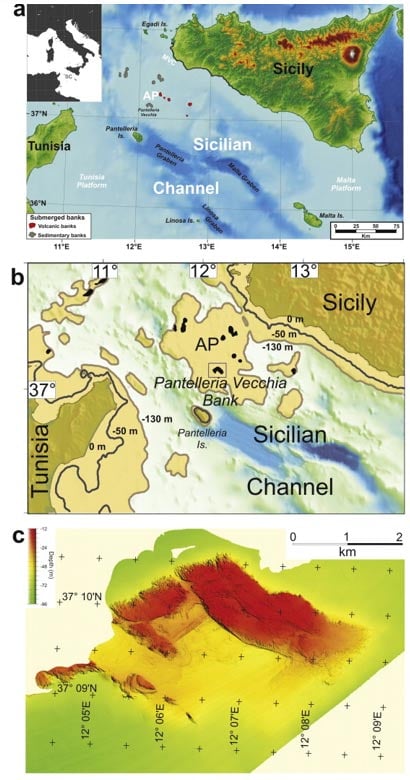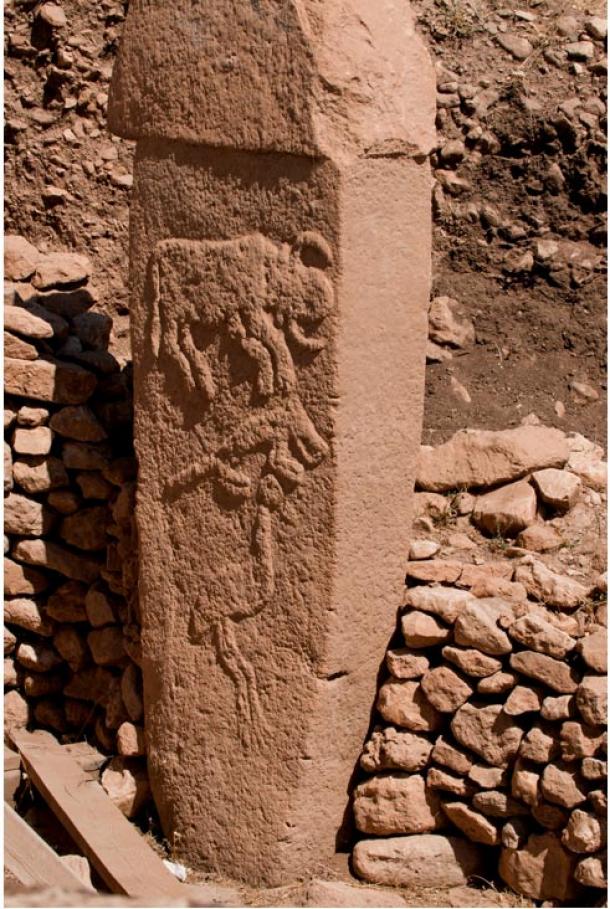
Underwater Discovery: Stone Age Humans Precisely Carved a 15 ton Stone Pillar and Carried it 300 Meters
At least 9,300 years ago, Stone Age hunter-gatherers in a now-submerged area of the Mediterranean Sea accomplished a feat that even most modern humans could not do: They apparently cut a 15-ton limestone pillar with precision, drilled holes in it and transported it nearly 300 meters (984 feet). The monolith is 12 meters (39 feet) long.
Oceanographers studying the Mediterranean sea floor in the Sicilian Channel between Tunisia and Sicily in 2012 found the monolith 40 meters (131 feet) deep. In a new paper in the Journal of Archaeological Science, the researchers say this area became submerged about 9,350 years ago, give or take 200 years. Before that, the area was shallow sea with an archipelago of several islands about halfway between the island of Sicily and the North African coast.
The researchers say the discovery of this submerged pillar may require scholars to rethink the idea of “technological primitivism” among hunter-gatherers.
Researchers were able to date the monolith by extracting shell fragments from it. The dating showed the pillar has the same composition and age as nearby limestone. Seawater covered the area when the last Ice Age ended around 9,350 years ago, so the pillar is assumed to have been fashioned at least that long ago.
“This discovery provides evidence for a significant Mesolithic human activity in the Sicilian Channel region,” write Emanuele Lodolo and Zvi Ben-Abraham in their paper.
- Pantalica: The Spectacular Honeycomb Tombs of Sicily
- Rare orichalcum metal said to be from the legendary Atlantis recovered from 2,600-year-old shipwreck
- The mysterious monoliths of Asuka Nara and the Rock Ship of Masuda
Lodolo and Ben-Abraham state in the report that several factors lead them to believe the monolith or stone column was cut by humans and was not shaped by nature. They write that the monolith has a regular shape and three regular holes of similar diameter. It is composed of limestone of a nature similar to rocks not far away from where it was transported, but it differs from the rocks in the immediate vicinity.
“The presence of the monolith suggests extensive human activity in the [area],” they write. “It was cut and extracted as a single stone from the outer rectilinear ridge situated about 300 m [984 feet] to the south, and then transported and possibly erected. From the size of the monolith, we may presume that it weighs about 15 [tons].”

The area studied, the Pantelleria Vecchia Bank, is now undersea between Sicily and Tunisia. It had been a shallow area with an archipelago before 9,500 years ago. (Journal of Archaeological Science)
The researchers also stated that they can't speculate about the function of the monolith, but they assume it was in an important area, which is about halfway between Sicily and Tunisia. In their article they claim that they assume people came from Sicily to the area now submerged because there was a 50 km (31 mile) seaway between there and what is now Tunisia. Sicily was inhabited possibly between 17,000 and 27,000 years ago, when there was a land bridge from the Italian mainland.
“The discovery of the submerged site in the Sicilian Channel may significantly expand our knowledge of the earliest civilizations in the Mediterranean basin and our views on technological innovation and development achieved by the Mesolithic inhabitants,” the authors write. “The monolith found, made of a single, large block, required a cutting, extraction, transportation and installation, which undoubtedly reveals important technical skills and great engineering. The belief that our ancestors lacked the knowledge, skill and technology to exploit marine resources or make sea crossings, must be progressively abandoned. The recent findings of submerged archaeology have definitively removed the idea of 'technological primitivism' often attributed to hunter-gatherers coastal settlers.”
The authors wrote that the age of the site places it at the start of the Mesolithic age. Another site from that era, Göbekli Tepe in southeastern Turkey, revolutionized how scholars think about the capabilities of Stone Age people. Scientists estimate, based on carbon dating, that Göbekli Tepe was built around 11,600 years ago, which is right at the beginning of the European Mesolithic age. The site is believed to have been a ceremonial or religious center for a settlement or settlements and had megalithic art and shrines.

A bison, fox and crane on a megalith at Göbekli Tepe in Turkey, a site dating back 11,600 years that made scholars rethink the technological capabilities of Stone Age people. (Photo by Teomancimit/Wikimedia Commons)
- The Weird Wolds of Yorkshire: Inside the Mysterious Wold Newton Triangle
- Uluru (Ayers Rock)
- Göbekli Tepe & The Great Year
“Göbekli Tepe has revolutionized archaeological and anthropological understanding of the Middle East Mesolithic. It demonstrates that the construction of a monumental complex was within the capability of a hunter-gatherer society, although scientists do not yet understand exactly how its builders managed to mobilize and feed a force large enough to complete the project. It's worth noting, for instance, that during the first two phases of construction, over two hundred large pillars, each weighing up to 20 tons, were erected and topped with huge limestone slabs. No other hunter-gatherer society has been able to match this feat” according to Lodolo and Ben-Abraham.
The authors say further explorations of the now-submerged Mediterranean sea floor shelves that were land before the last Ice Age for evidence of human settlements is necessary to understand origins of civilizations in the area.
Featured image: A series of photos of the monolith on the sea floor Note the precise hole in the monolith as photographed by a diver studying the now-submerged area off the coasts of Tunisia and Sicily. (ScienceDirect)
By Mark Miller
















Comments
We don't use the term “Stone Age” as an insult. It is simply a layman’s term for the Paleolithic, which means Stone Age. I am not sure all readers know what Paleolithic means, so I write “Stone Age” a lot.
Mark Miller
Apparently they weren't so ‘stone-age’ afterall cuz they could carve and carry this thing 300m underwater!
The term ‘stone-age’ is proof western civilization hasn’t a clue of real history over 5 millenia ago. The sphinx screams of water erosion and the great pyramid has salt water erosion half way up it’s sides. There hasn’t been water in the Giza plateau for 12000 yrs.
History of Persian empire. Zoroastrianism.
Hoshang